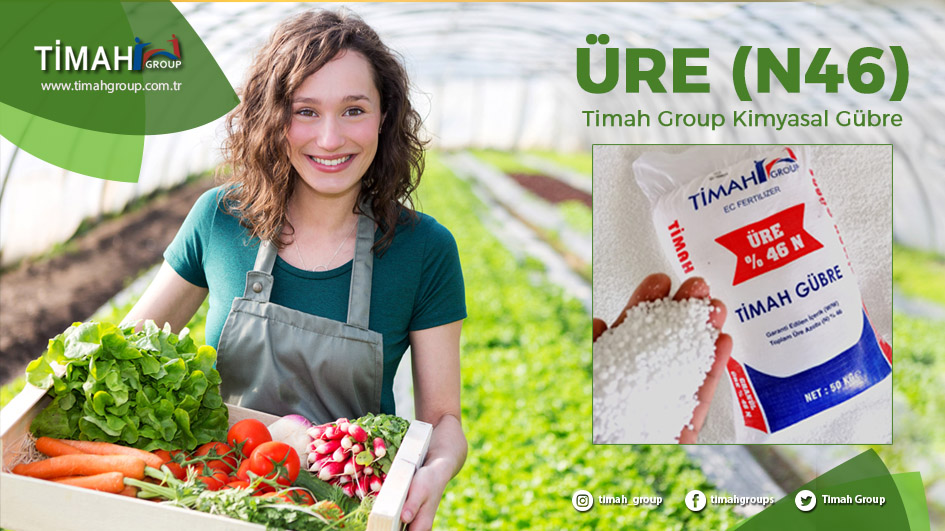Urea Fertilizer 46-0-0
- What is Urea Fertilizer 46-0-0 and What are Its Uses?
- Types of Urea Fertilizer
- Benefits of Urea Fertilizer
- Important Considerations for Using Urea Fertilizer
- When and Where to Use Urea Fertilizer
- TİMAH GROUP Urea Fertilizer
- When to Apply Urea Fertilizer?
Do not store in the same closed environment as Ammonium Sulfate AS.
Chemical Fertilizer: What is Urea Fertilizer 46-0-0 and What are Its Uses?
What is Urea Fertilizer? Urea fertilizer, with a 46% nitrogen content, is one of the highest nitrogen-containing chemical fertilizers. This white, odorless, water-soluble fertilizer comes in prilled or granular form and can be used throughout the production period for all plants. Urea promotes stem growth and root development in plants, encouraging green foliage formation, which allows plants to better utilize sunlight and thus increase their yield. When applied in small amounts, plant growth slows, and grain and fruit yield decrease.

Benefits of Urea Fertilizer: Plants can directly absorb urea nitrogen, but for it to be more beneficial, it needs to convert to ammonium and nitrate. Considering this conversion process, urea should be applied earlier than other nitrogenous fertilizers. When large amounts of urea are needed, it should be applied in several split doses rather than all at once. After urea is applied to the soil, it should be immediately mixed into the soil to prevent nitrogen loss from the surface.
Types of Urea Fertilizer
Urea fertilizer is known for its high nitrogen content. However, two and three-nutrient compound fertilizers often contain urea as well. Therefore, compound fertilizers like 20-20-0 (nitrogen, phosphorus) and 15-15-15 (nitrogen, phosphorus, and potassium) are also commonly referred to as urea fertilizers.
Benefits of Urea Fertilizer
Urea fertilizer accelerates crop growth, acts as a growth promoter, and has a root-developing effect. It plays a significant role in fruit and grain development and is a fundamental support for the cultivation of cereals and corn. According to the Plant Nutrition course notes from Bingöl University, the benefits of urea fertilizer have led to its widespread use worldwide. Four main reasons are highlighted:
- High nitrogen content in Urea (46% N) makes it a preferred choice.
- Its high agricultural value leads to frequent use.
- Urea (46% N) fertilizer is preferred because it causes less rusting on agricultural machinery.
- Its physical properties, such as rapid solubility in water and ease of application, make it more attractive.
When considering nitrogen cost per unit, urea (46% N) is much cheaper. Additionally, its non-flammable nature reduces storage risks, and its neutral pH characteristic prevents damage to crops.
Important Considerations for Using Urea Fertilizer
When used correctly, urea fertilizer does not cause harm. However, if it comes into contact with the plant roots or seeds during soil application, it can damage the plants, inhibit seed germination, or completely prevent it. Excessive use of urea can make the soil acidic and reduce its natural fertility. Overuse can also harm the environment and contribute to atmospheric pollution.
When and Where to Use Urea Fertilizer
Urea fertilizer can be used before, during, and after planting. It is commonly used in rainy regions but is also suitable for semi-arid and arid regions. In dry areas, applying urea before rainfall and incorporating it into the soil prevents nitrogen loss. Urea fertilizer is suitable for almost all vegetables, grains, fruits, and crops. It can be applied as a basal or top dressing and should be mixed into the soil immediately after application.
TİMAH GROUP Urea Fertilizer
TİMAH GROUP offers urea fertilizer with economic price guarantees, cash or installment payment options, providing advantages for users. For your urea fertilizer needs, you can benefit from the advantages offered by TİMAH GROUP.
When to Apply Urea Fertilizer?
There is no definitive answer to the question of when to apply urea fertilizer. It is especially used in spring, but it can also be preferred over other fertilizers in summer. Urea fertilizer benefits crops throughout their growth stages and can be applied before, during, and after planting, either as a basal or top dressing.